Analyzing Communication Theories in Nurse-Patient Relationships
VerifiedAdded on 2023/04/21
|13
|3830
|444
Essay
AI Summary
This essay examines the application of communication theories in fostering effective nurse-patient relationships within a hospital setting. It highlights the importance of a strong nurse-patient bond in facilitating patient recovery and information disclosure. The essay focuses on the application of Peplau’s interpersonal relations theory, emphasizing the therapeutic relationship between the nurse and the patient, including the orientation phase, building trust, and addressing treatment goals. It also discusses communication barriers such as patient anxiety, pain, sensory problems, and a noisy environment, along with communication techniques used by the patient, including silence, questioning, listening, and honesty. The essay further emphasizes the importance of demonstrating empathy, respect, and dignity in nurse-patient interactions to enhance the therapeutic relationship and improve patient care. This analysis provides insights into how communication theories can be practically applied to create a secure and supportive environment for patients.
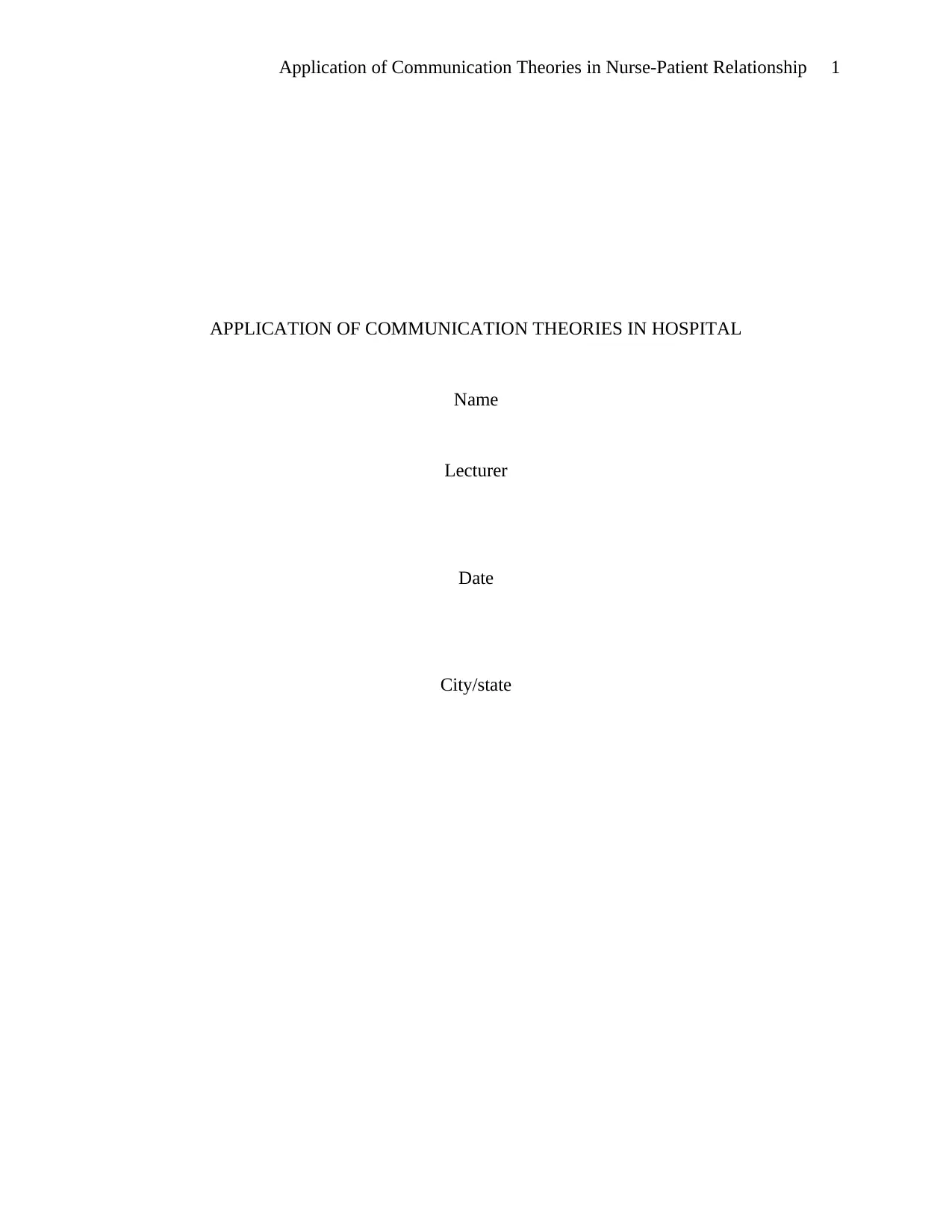
Application of Communication Theories in Nurse-Patient Relationship 1
APPLICATION OF COMMUNICATION THEORIES IN HOSPITAL
Name
Lecturer
Date
City/state
APPLICATION OF COMMUNICATION THEORIES IN HOSPITAL
Name
Lecturer
Date
City/state
Paraphrase This Document
Need a fresh take? Get an instant paraphrase of this document with our AI Paraphraser
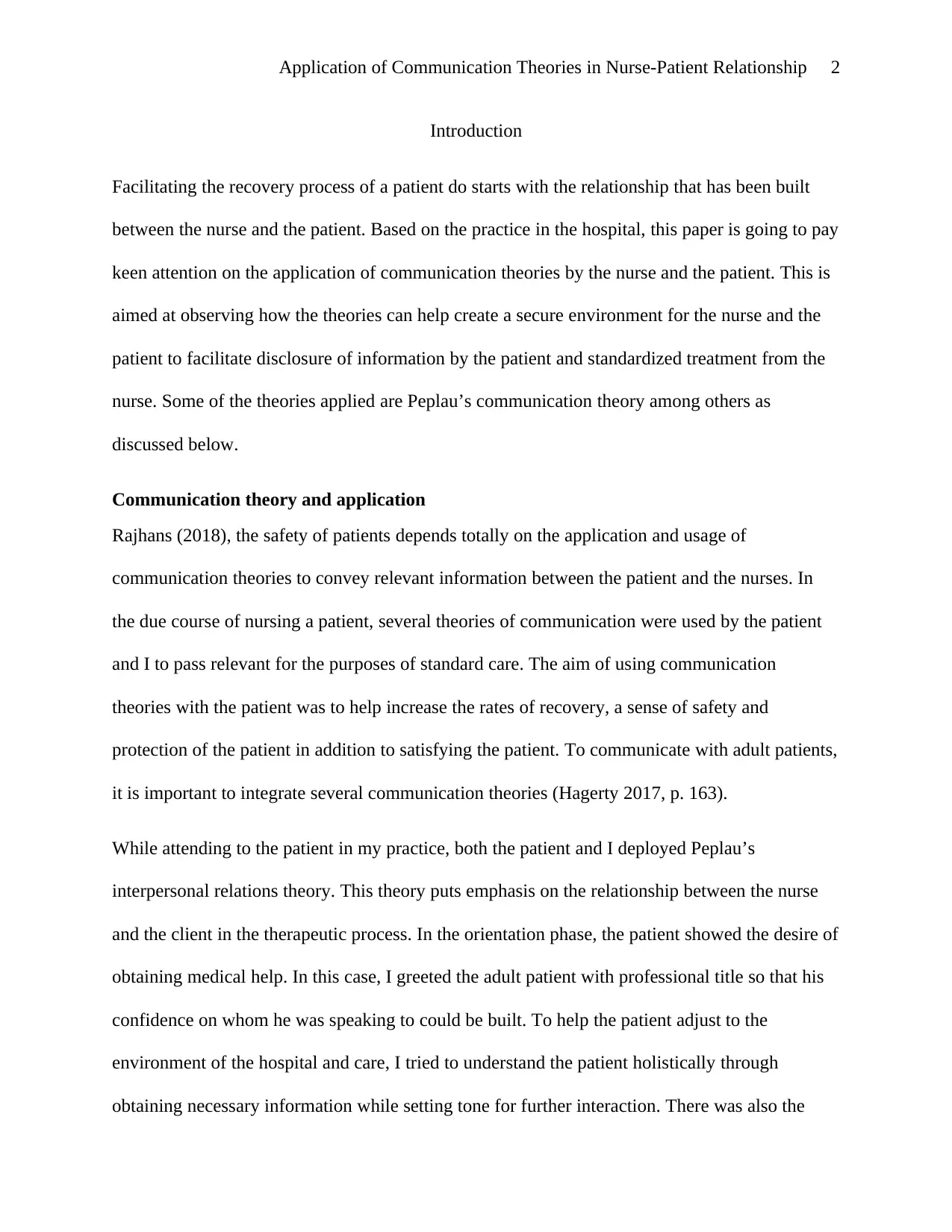
Application of Communication Theories in Nurse-Patient Relationship 2
Introduction
Facilitating the recovery process of a patient do starts with the relationship that has been built
between the nurse and the patient. Based on the practice in the hospital, this paper is going to pay
keen attention on the application of communication theories by the nurse and the patient. This is
aimed at observing how the theories can help create a secure environment for the nurse and the
patient to facilitate disclosure of information by the patient and standardized treatment from the
nurse. Some of the theories applied are Peplau’s communication theory among others as
discussed below.
Communication theory and application
Rajhans (2018), the safety of patients depends totally on the application and usage of
communication theories to convey relevant information between the patient and the nurses. In
the due course of nursing a patient, several theories of communication were used by the patient
and I to pass relevant for the purposes of standard care. The aim of using communication
theories with the patient was to help increase the rates of recovery, a sense of safety and
protection of the patient in addition to satisfying the patient. To communicate with adult patients,
it is important to integrate several communication theories (Hagerty 2017, p. 163).
While attending to the patient in my practice, both the patient and I deployed Peplau’s
interpersonal relations theory. This theory puts emphasis on the relationship between the nurse
and the client in the therapeutic process. In the orientation phase, the patient showed the desire of
obtaining medical help. In this case, I greeted the adult patient with professional title so that his
confidence on whom he was speaking to could be built. To help the patient adjust to the
environment of the hospital and care, I tried to understand the patient holistically through
obtaining necessary information while setting tone for further interaction. There was also the
Introduction
Facilitating the recovery process of a patient do starts with the relationship that has been built
between the nurse and the patient. Based on the practice in the hospital, this paper is going to pay
keen attention on the application of communication theories by the nurse and the patient. This is
aimed at observing how the theories can help create a secure environment for the nurse and the
patient to facilitate disclosure of information by the patient and standardized treatment from the
nurse. Some of the theories applied are Peplau’s communication theory among others as
discussed below.
Communication theory and application
Rajhans (2018), the safety of patients depends totally on the application and usage of
communication theories to convey relevant information between the patient and the nurses. In
the due course of nursing a patient, several theories of communication were used by the patient
and I to pass relevant for the purposes of standard care. The aim of using communication
theories with the patient was to help increase the rates of recovery, a sense of safety and
protection of the patient in addition to satisfying the patient. To communicate with adult patients,
it is important to integrate several communication theories (Hagerty 2017, p. 163).
While attending to the patient in my practice, both the patient and I deployed Peplau’s
interpersonal relations theory. This theory puts emphasis on the relationship between the nurse
and the client in the therapeutic process. In the orientation phase, the patient showed the desire of
obtaining medical help. In this case, I greeted the adult patient with professional title so that his
confidence on whom he was speaking to could be built. To help the patient adjust to the
environment of the hospital and care, I tried to understand the patient holistically through
obtaining necessary information while setting tone for further interaction. There was also the
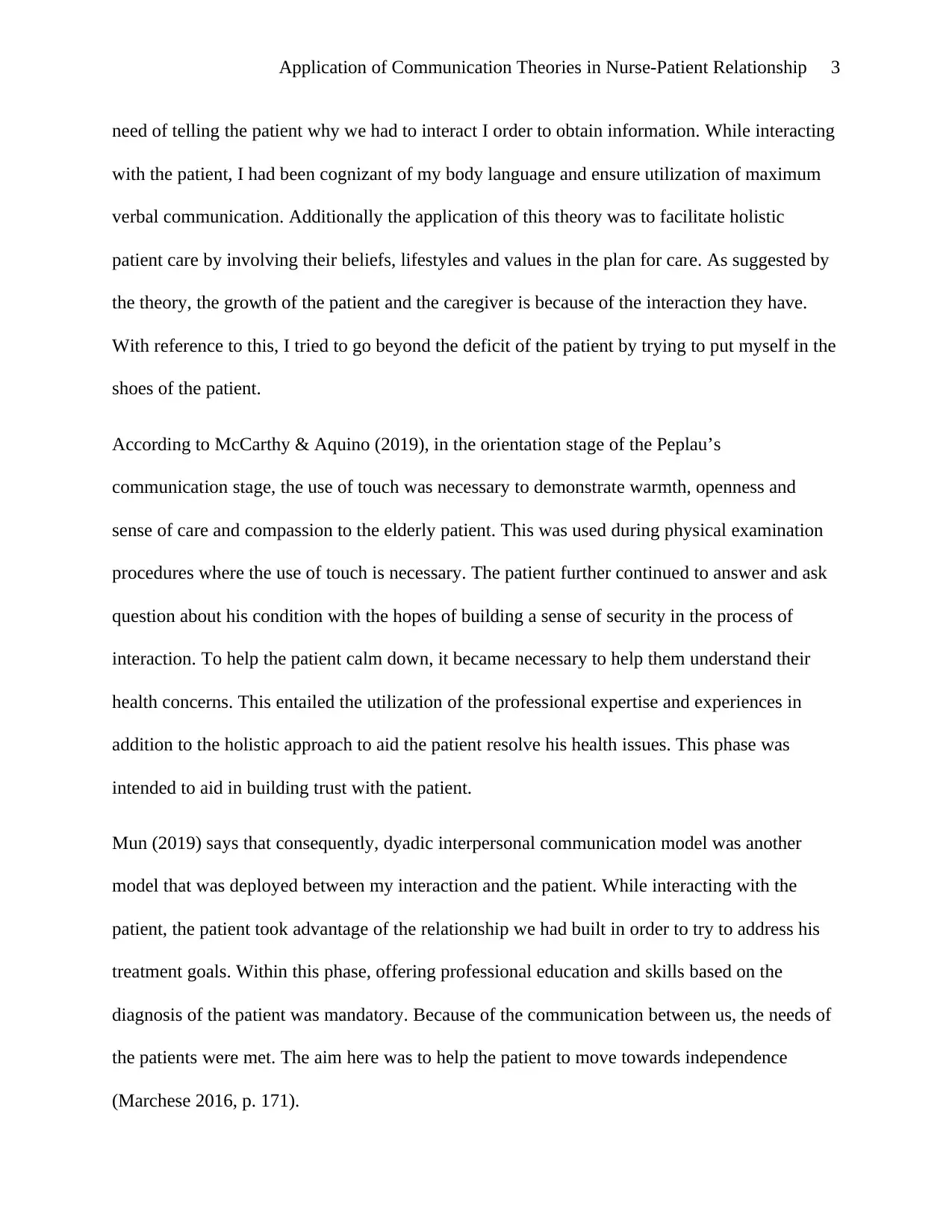
Application of Communication Theories in Nurse-Patient Relationship 3
need of telling the patient why we had to interact I order to obtain information. While interacting
with the patient, I had been cognizant of my body language and ensure utilization of maximum
verbal communication. Additionally the application of this theory was to facilitate holistic
patient care by involving their beliefs, lifestyles and values in the plan for care. As suggested by
the theory, the growth of the patient and the caregiver is because of the interaction they have.
With reference to this, I tried to go beyond the deficit of the patient by trying to put myself in the
shoes of the patient.
According to McCarthy & Aquino (2019), in the orientation stage of the Peplau’s
communication stage, the use of touch was necessary to demonstrate warmth, openness and
sense of care and compassion to the elderly patient. This was used during physical examination
procedures where the use of touch is necessary. The patient further continued to answer and ask
question about his condition with the hopes of building a sense of security in the process of
interaction. To help the patient calm down, it became necessary to help them understand their
health concerns. This entailed the utilization of the professional expertise and experiences in
addition to the holistic approach to aid the patient resolve his health issues. This phase was
intended to aid in building trust with the patient.
Mun (2019) says that consequently, dyadic interpersonal communication model was another
model that was deployed between my interaction and the patient. While interacting with the
patient, the patient took advantage of the relationship we had built in order to try to address his
treatment goals. Within this phase, offering professional education and skills based on the
diagnosis of the patient was mandatory. Because of the communication between us, the needs of
the patients were met. The aim here was to help the patient to move towards independence
(Marchese 2016, p. 171).
need of telling the patient why we had to interact I order to obtain information. While interacting
with the patient, I had been cognizant of my body language and ensure utilization of maximum
verbal communication. Additionally the application of this theory was to facilitate holistic
patient care by involving their beliefs, lifestyles and values in the plan for care. As suggested by
the theory, the growth of the patient and the caregiver is because of the interaction they have.
With reference to this, I tried to go beyond the deficit of the patient by trying to put myself in the
shoes of the patient.
According to McCarthy & Aquino (2019), in the orientation stage of the Peplau’s
communication stage, the use of touch was necessary to demonstrate warmth, openness and
sense of care and compassion to the elderly patient. This was used during physical examination
procedures where the use of touch is necessary. The patient further continued to answer and ask
question about his condition with the hopes of building a sense of security in the process of
interaction. To help the patient calm down, it became necessary to help them understand their
health concerns. This entailed the utilization of the professional expertise and experiences in
addition to the holistic approach to aid the patient resolve his health issues. This phase was
intended to aid in building trust with the patient.
Mun (2019) says that consequently, dyadic interpersonal communication model was another
model that was deployed between my interaction and the patient. While interacting with the
patient, the patient took advantage of the relationship we had built in order to try to address his
treatment goals. Within this phase, offering professional education and skills based on the
diagnosis of the patient was mandatory. Because of the communication between us, the needs of
the patients were met. The aim here was to help the patient to move towards independence
(Marchese 2016, p. 171).
⊘ This is a preview!⊘
Do you want full access?
Subscribe today to unlock all pages.

Trusted by 1+ million students worldwide
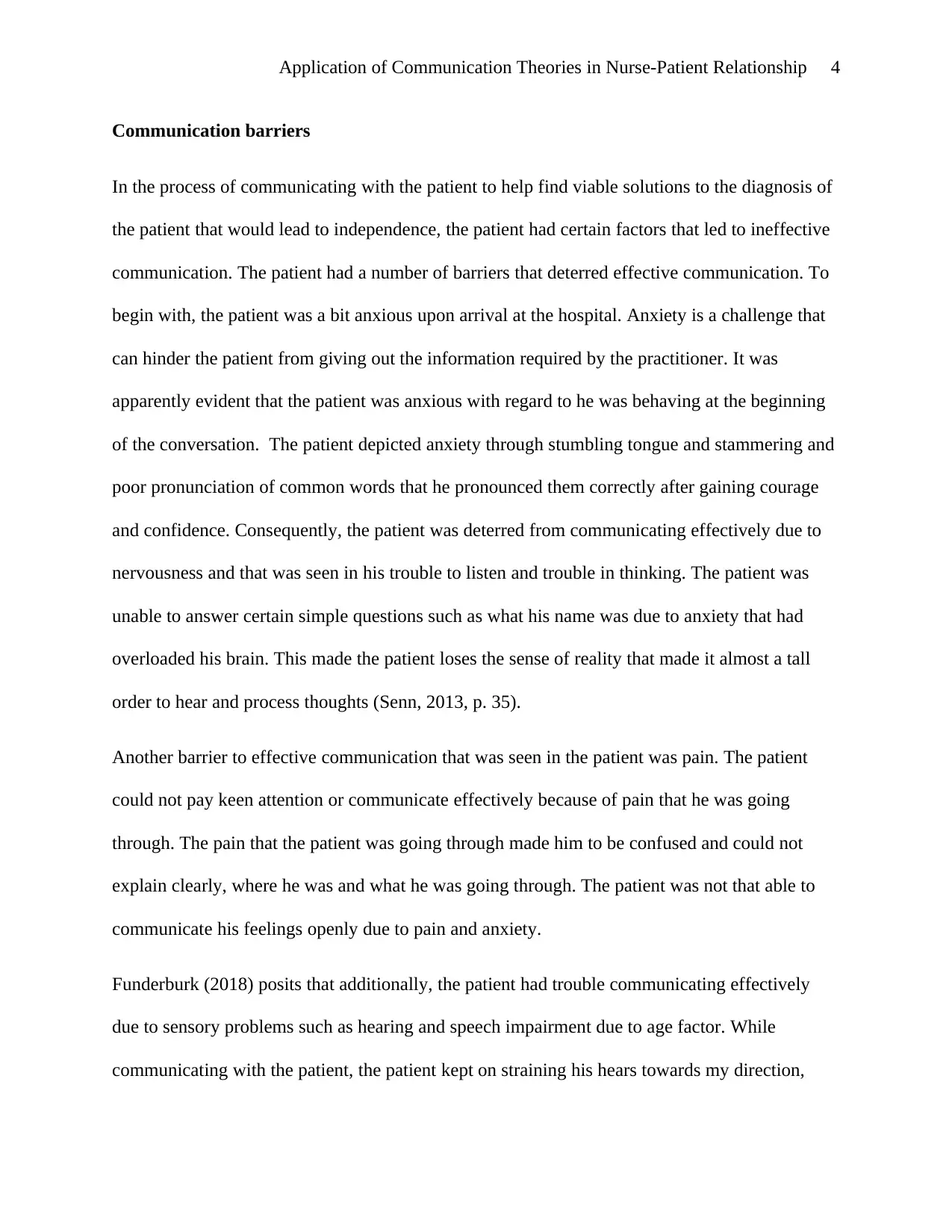
Application of Communication Theories in Nurse-Patient Relationship 4
Communication barriers
In the process of communicating with the patient to help find viable solutions to the diagnosis of
the patient that would lead to independence, the patient had certain factors that led to ineffective
communication. The patient had a number of barriers that deterred effective communication. To
begin with, the patient was a bit anxious upon arrival at the hospital. Anxiety is a challenge that
can hinder the patient from giving out the information required by the practitioner. It was
apparently evident that the patient was anxious with regard to he was behaving at the beginning
of the conversation. The patient depicted anxiety through stumbling tongue and stammering and
poor pronunciation of common words that he pronounced them correctly after gaining courage
and confidence. Consequently, the patient was deterred from communicating effectively due to
nervousness and that was seen in his trouble to listen and trouble in thinking. The patient was
unable to answer certain simple questions such as what his name was due to anxiety that had
overloaded his brain. This made the patient loses the sense of reality that made it almost a tall
order to hear and process thoughts (Senn, 2013, p. 35).
Another barrier to effective communication that was seen in the patient was pain. The patient
could not pay keen attention or communicate effectively because of pain that he was going
through. The pain that the patient was going through made him to be confused and could not
explain clearly, where he was and what he was going through. The patient was not that able to
communicate his feelings openly due to pain and anxiety.
Funderburk (2018) posits that additionally, the patient had trouble communicating effectively
due to sensory problems such as hearing and speech impairment due to age factor. While
communicating with the patient, the patient kept on straining his hears towards my direction,
Communication barriers
In the process of communicating with the patient to help find viable solutions to the diagnosis of
the patient that would lead to independence, the patient had certain factors that led to ineffective
communication. The patient had a number of barriers that deterred effective communication. To
begin with, the patient was a bit anxious upon arrival at the hospital. Anxiety is a challenge that
can hinder the patient from giving out the information required by the practitioner. It was
apparently evident that the patient was anxious with regard to he was behaving at the beginning
of the conversation. The patient depicted anxiety through stumbling tongue and stammering and
poor pronunciation of common words that he pronounced them correctly after gaining courage
and confidence. Consequently, the patient was deterred from communicating effectively due to
nervousness and that was seen in his trouble to listen and trouble in thinking. The patient was
unable to answer certain simple questions such as what his name was due to anxiety that had
overloaded his brain. This made the patient loses the sense of reality that made it almost a tall
order to hear and process thoughts (Senn, 2013, p. 35).
Another barrier to effective communication that was seen in the patient was pain. The patient
could not pay keen attention or communicate effectively because of pain that he was going
through. The pain that the patient was going through made him to be confused and could not
explain clearly, where he was and what he was going through. The patient was not that able to
communicate his feelings openly due to pain and anxiety.
Funderburk (2018) posits that additionally, the patient had trouble communicating effectively
due to sensory problems such as hearing and speech impairment due to age factor. While
communicating with the patient, the patient kept on straining his hears towards my direction,
Paraphrase This Document
Need a fresh take? Get an instant paraphrase of this document with our AI Paraphraser
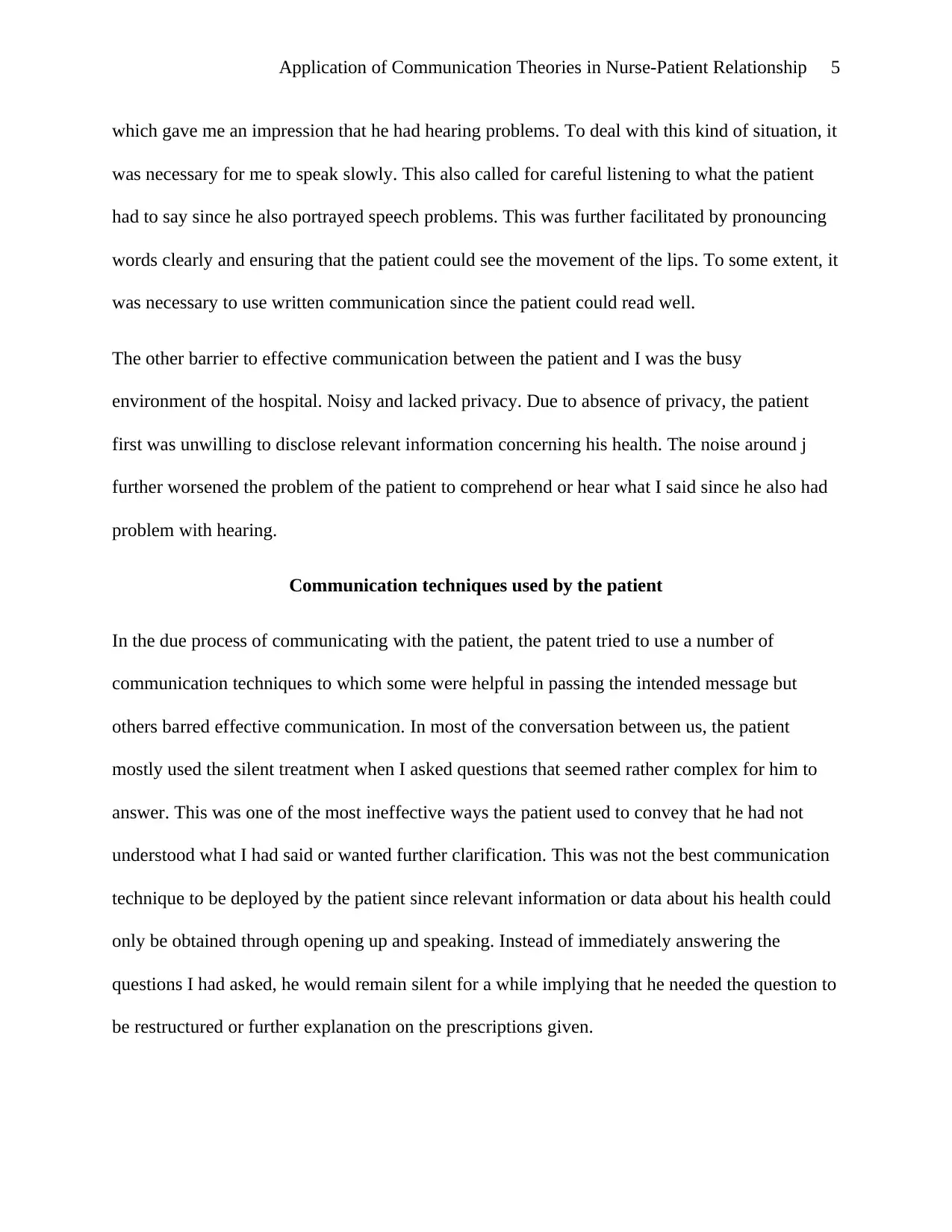
Application of Communication Theories in Nurse-Patient Relationship 5
which gave me an impression that he had hearing problems. To deal with this kind of situation, it
was necessary for me to speak slowly. This also called for careful listening to what the patient
had to say since he also portrayed speech problems. This was further facilitated by pronouncing
words clearly and ensuring that the patient could see the movement of the lips. To some extent, it
was necessary to use written communication since the patient could read well.
The other barrier to effective communication between the patient and I was the busy
environment of the hospital. Noisy and lacked privacy. Due to absence of privacy, the patient
first was unwilling to disclose relevant information concerning his health. The noise around j
further worsened the problem of the patient to comprehend or hear what I said since he also had
problem with hearing.
Communication techniques used by the patient
In the due process of communicating with the patient, the patent tried to use a number of
communication techniques to which some were helpful in passing the intended message but
others barred effective communication. In most of the conversation between us, the patient
mostly used the silent treatment when I asked questions that seemed rather complex for him to
answer. This was one of the most ineffective ways the patient used to convey that he had not
understood what I had said or wanted further clarification. This was not the best communication
technique to be deployed by the patient since relevant information or data about his health could
only be obtained through opening up and speaking. Instead of immediately answering the
questions I had asked, he would remain silent for a while implying that he needed the question to
be restructured or further explanation on the prescriptions given.
which gave me an impression that he had hearing problems. To deal with this kind of situation, it
was necessary for me to speak slowly. This also called for careful listening to what the patient
had to say since he also portrayed speech problems. This was further facilitated by pronouncing
words clearly and ensuring that the patient could see the movement of the lips. To some extent, it
was necessary to use written communication since the patient could read well.
The other barrier to effective communication between the patient and I was the busy
environment of the hospital. Noisy and lacked privacy. Due to absence of privacy, the patient
first was unwilling to disclose relevant information concerning his health. The noise around j
further worsened the problem of the patient to comprehend or hear what I said since he also had
problem with hearing.
Communication techniques used by the patient
In the due process of communicating with the patient, the patent tried to use a number of
communication techniques to which some were helpful in passing the intended message but
others barred effective communication. In most of the conversation between us, the patient
mostly used the silent treatment when I asked questions that seemed rather complex for him to
answer. This was one of the most ineffective ways the patient used to convey that he had not
understood what I had said or wanted further clarification. This was not the best communication
technique to be deployed by the patient since relevant information or data about his health could
only be obtained through opening up and speaking. Instead of immediately answering the
questions I had asked, he would remain silent for a while implying that he needed the question to
be restructured or further explanation on the prescriptions given.
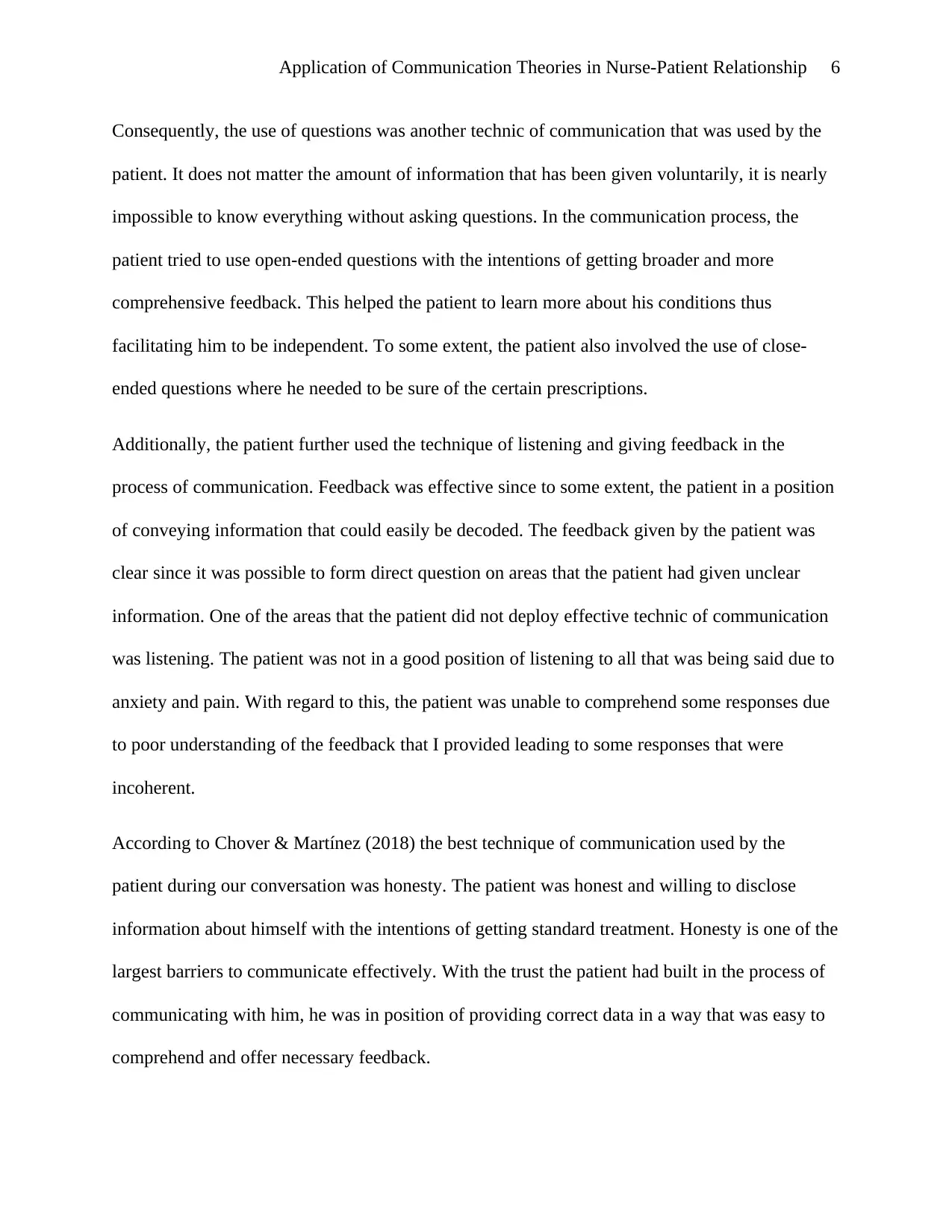
Application of Communication Theories in Nurse-Patient Relationship 6
Consequently, the use of questions was another technic of communication that was used by the
patient. It does not matter the amount of information that has been given voluntarily, it is nearly
impossible to know everything without asking questions. In the communication process, the
patient tried to use open-ended questions with the intentions of getting broader and more
comprehensive feedback. This helped the patient to learn more about his conditions thus
facilitating him to be independent. To some extent, the patient also involved the use of close-
ended questions where he needed to be sure of the certain prescriptions.
Additionally, the patient further used the technique of listening and giving feedback in the
process of communication. Feedback was effective since to some extent, the patient in a position
of conveying information that could easily be decoded. The feedback given by the patient was
clear since it was possible to form direct question on areas that the patient had given unclear
information. One of the areas that the patient did not deploy effective technic of communication
was listening. The patient was not in a good position of listening to all that was being said due to
anxiety and pain. With regard to this, the patient was unable to comprehend some responses due
to poor understanding of the feedback that I provided leading to some responses that were
incoherent.
According to Chover & Martínez (2018) the best technique of communication used by the
patient during our conversation was honesty. The patient was honest and willing to disclose
information about himself with the intentions of getting standard treatment. Honesty is one of the
largest barriers to communicate effectively. With the trust the patient had built in the process of
communicating with him, he was in position of providing correct data in a way that was easy to
comprehend and offer necessary feedback.
Consequently, the use of questions was another technic of communication that was used by the
patient. It does not matter the amount of information that has been given voluntarily, it is nearly
impossible to know everything without asking questions. In the communication process, the
patient tried to use open-ended questions with the intentions of getting broader and more
comprehensive feedback. This helped the patient to learn more about his conditions thus
facilitating him to be independent. To some extent, the patient also involved the use of close-
ended questions where he needed to be sure of the certain prescriptions.
Additionally, the patient further used the technique of listening and giving feedback in the
process of communication. Feedback was effective since to some extent, the patient in a position
of conveying information that could easily be decoded. The feedback given by the patient was
clear since it was possible to form direct question on areas that the patient had given unclear
information. One of the areas that the patient did not deploy effective technic of communication
was listening. The patient was not in a good position of listening to all that was being said due to
anxiety and pain. With regard to this, the patient was unable to comprehend some responses due
to poor understanding of the feedback that I provided leading to some responses that were
incoherent.
According to Chover & Martínez (2018) the best technique of communication used by the
patient during our conversation was honesty. The patient was honest and willing to disclose
information about himself with the intentions of getting standard treatment. Honesty is one of the
largest barriers to communicate effectively. With the trust the patient had built in the process of
communicating with him, he was in position of providing correct data in a way that was easy to
comprehend and offer necessary feedback.
⊘ This is a preview!⊘
Do you want full access?
Subscribe today to unlock all pages.

Trusted by 1+ million students worldwide
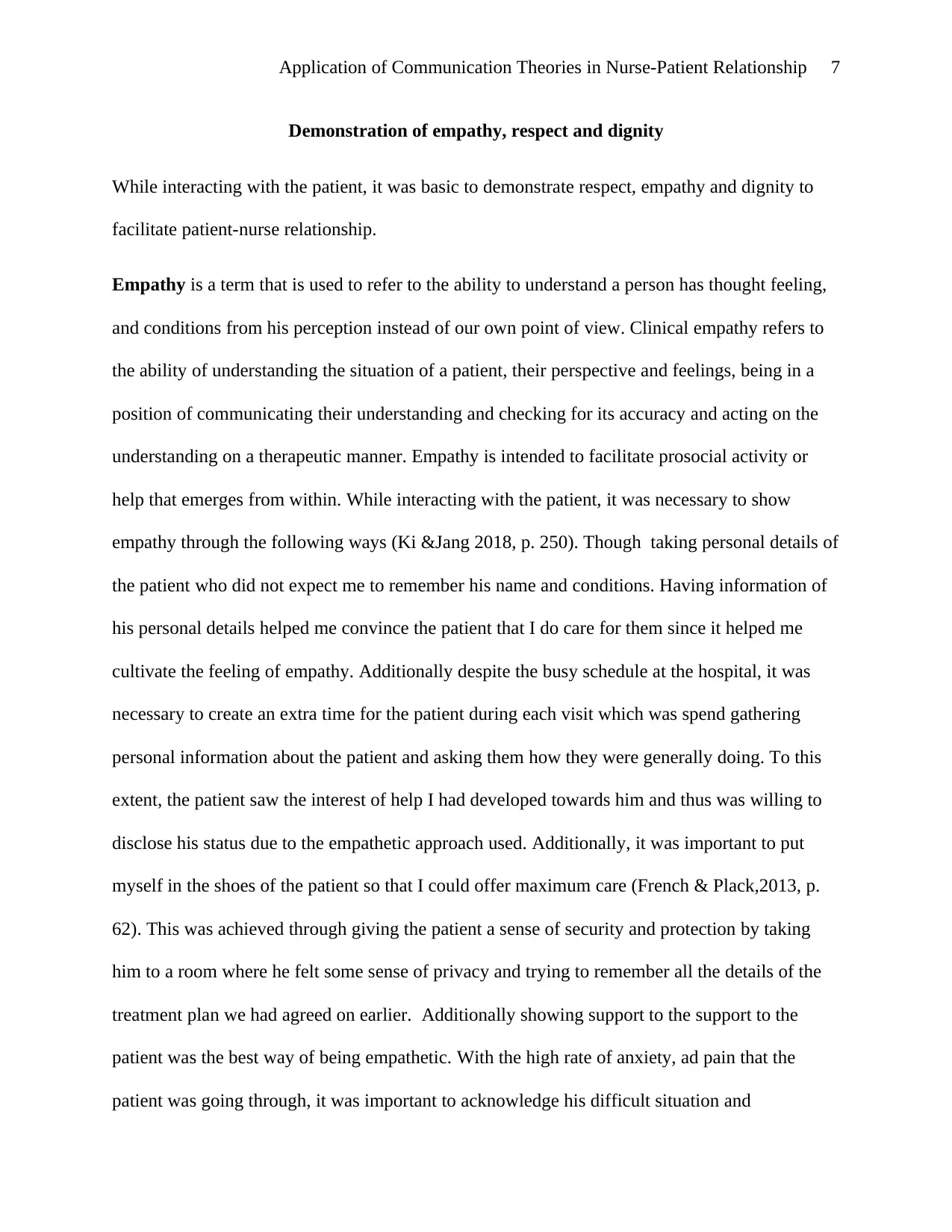
Application of Communication Theories in Nurse-Patient Relationship 7
Demonstration of empathy, respect and dignity
While interacting with the patient, it was basic to demonstrate respect, empathy and dignity to
facilitate patient-nurse relationship.
Empathy is a term that is used to refer to the ability to understand a person has thought feeling,
and conditions from his perception instead of our own point of view. Clinical empathy refers to
the ability of understanding the situation of a patient, their perspective and feelings, being in a
position of communicating their understanding and checking for its accuracy and acting on the
understanding on a therapeutic manner. Empathy is intended to facilitate prosocial activity or
help that emerges from within. While interacting with the patient, it was necessary to show
empathy through the following ways (Ki &Jang 2018, p. 250). Though taking personal details of
the patient who did not expect me to remember his name and conditions. Having information of
his personal details helped me convince the patient that I do care for them since it helped me
cultivate the feeling of empathy. Additionally despite the busy schedule at the hospital, it was
necessary to create an extra time for the patient during each visit which was spend gathering
personal information about the patient and asking them how they were generally doing. To this
extent, the patient saw the interest of help I had developed towards him and thus was willing to
disclose his status due to the empathetic approach used. Additionally, it was important to put
myself in the shoes of the patient so that I could offer maximum care (French & Plack,2013, p.
62). This was achieved through giving the patient a sense of security and protection by taking
him to a room where he felt some sense of privacy and trying to remember all the details of the
treatment plan we had agreed on earlier. Additionally showing support to the support to the
patient was the best way of being empathetic. With the high rate of anxiety, ad pain that the
patient was going through, it was important to acknowledge his difficult situation and
Demonstration of empathy, respect and dignity
While interacting with the patient, it was basic to demonstrate respect, empathy and dignity to
facilitate patient-nurse relationship.
Empathy is a term that is used to refer to the ability to understand a person has thought feeling,
and conditions from his perception instead of our own point of view. Clinical empathy refers to
the ability of understanding the situation of a patient, their perspective and feelings, being in a
position of communicating their understanding and checking for its accuracy and acting on the
understanding on a therapeutic manner. Empathy is intended to facilitate prosocial activity or
help that emerges from within. While interacting with the patient, it was necessary to show
empathy through the following ways (Ki &Jang 2018, p. 250). Though taking personal details of
the patient who did not expect me to remember his name and conditions. Having information of
his personal details helped me convince the patient that I do care for them since it helped me
cultivate the feeling of empathy. Additionally despite the busy schedule at the hospital, it was
necessary to create an extra time for the patient during each visit which was spend gathering
personal information about the patient and asking them how they were generally doing. To this
extent, the patient saw the interest of help I had developed towards him and thus was willing to
disclose his status due to the empathetic approach used. Additionally, it was important to put
myself in the shoes of the patient so that I could offer maximum care (French & Plack,2013, p.
62). This was achieved through giving the patient a sense of security and protection by taking
him to a room where he felt some sense of privacy and trying to remember all the details of the
treatment plan we had agreed on earlier. Additionally showing support to the support to the
patient was the best way of being empathetic. With the high rate of anxiety, ad pain that the
patient was going through, it was important to acknowledge his difficult situation and
Paraphrase This Document
Need a fresh take? Get an instant paraphrase of this document with our AI Paraphraser
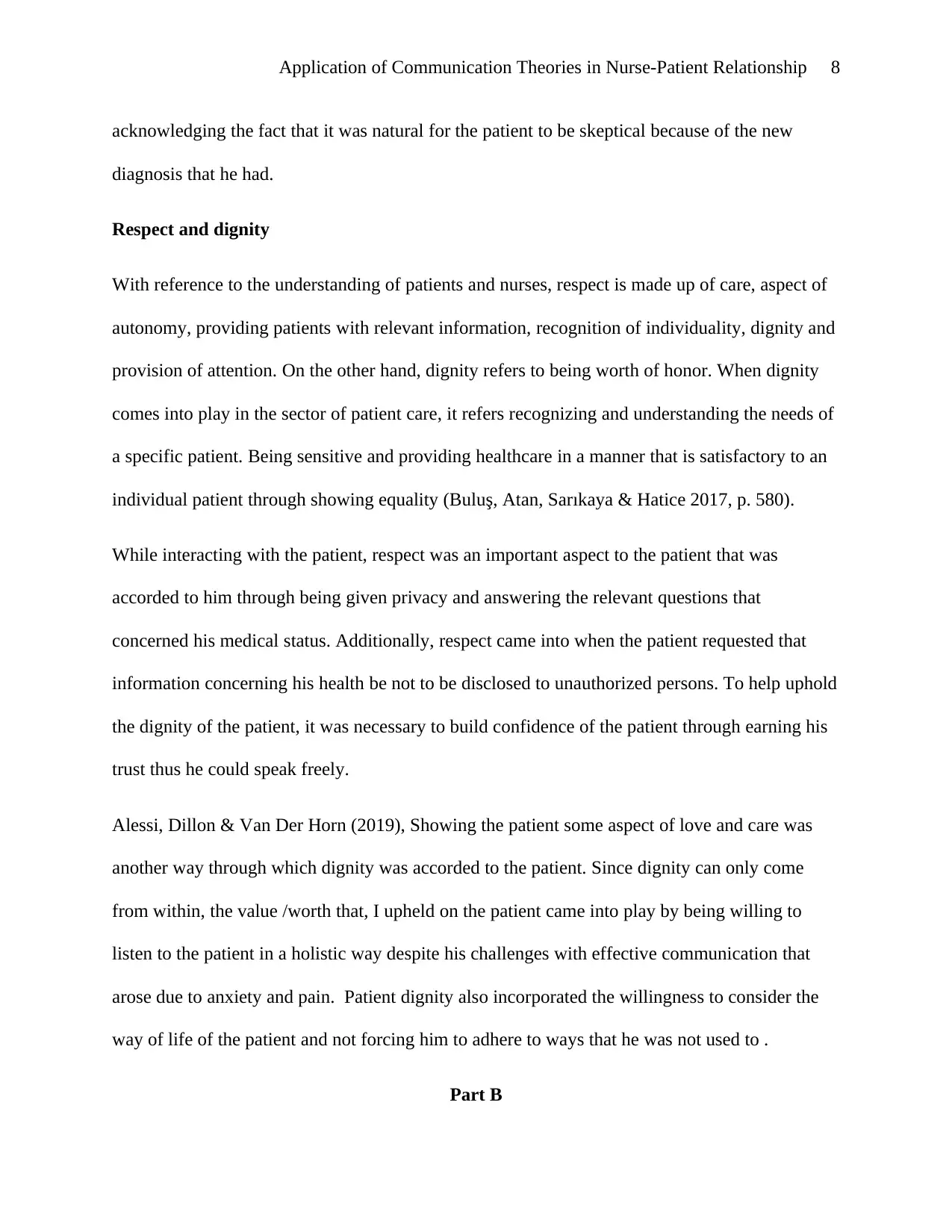
Application of Communication Theories in Nurse-Patient Relationship 8
acknowledging the fact that it was natural for the patient to be skeptical because of the new
diagnosis that he had.
Respect and dignity
With reference to the understanding of patients and nurses, respect is made up of care, aspect of
autonomy, providing patients with relevant information, recognition of individuality, dignity and
provision of attention. On the other hand, dignity refers to being worth of honor. When dignity
comes into play in the sector of patient care, it refers recognizing and understanding the needs of
a specific patient. Being sensitive and providing healthcare in a manner that is satisfactory to an
individual patient through showing equality (Buluş, Atan, Sarıkaya & Hatice 2017, p. 580).
While interacting with the patient, respect was an important aspect to the patient that was
accorded to him through being given privacy and answering the relevant questions that
concerned his medical status. Additionally, respect came into when the patient requested that
information concerning his health be not to be disclosed to unauthorized persons. To help uphold
the dignity of the patient, it was necessary to build confidence of the patient through earning his
trust thus he could speak freely.
Alessi, Dillon & Van Der Horn (2019), Showing the patient some aspect of love and care was
another way through which dignity was accorded to the patient. Since dignity can only come
from within, the value /worth that, I upheld on the patient came into play by being willing to
listen to the patient in a holistic way despite his challenges with effective communication that
arose due to anxiety and pain. Patient dignity also incorporated the willingness to consider the
way of life of the patient and not forcing him to adhere to ways that he was not used to .
Part B
acknowledging the fact that it was natural for the patient to be skeptical because of the new
diagnosis that he had.
Respect and dignity
With reference to the understanding of patients and nurses, respect is made up of care, aspect of
autonomy, providing patients with relevant information, recognition of individuality, dignity and
provision of attention. On the other hand, dignity refers to being worth of honor. When dignity
comes into play in the sector of patient care, it refers recognizing and understanding the needs of
a specific patient. Being sensitive and providing healthcare in a manner that is satisfactory to an
individual patient through showing equality (Buluş, Atan, Sarıkaya & Hatice 2017, p. 580).
While interacting with the patient, respect was an important aspect to the patient that was
accorded to him through being given privacy and answering the relevant questions that
concerned his medical status. Additionally, respect came into when the patient requested that
information concerning his health be not to be disclosed to unauthorized persons. To help uphold
the dignity of the patient, it was necessary to build confidence of the patient through earning his
trust thus he could speak freely.
Alessi, Dillon & Van Der Horn (2019), Showing the patient some aspect of love and care was
another way through which dignity was accorded to the patient. Since dignity can only come
from within, the value /worth that, I upheld on the patient came into play by being willing to
listen to the patient in a holistic way despite his challenges with effective communication that
arose due to anxiety and pain. Patient dignity also incorporated the willingness to consider the
way of life of the patient and not forcing him to adhere to ways that he was not used to .
Part B
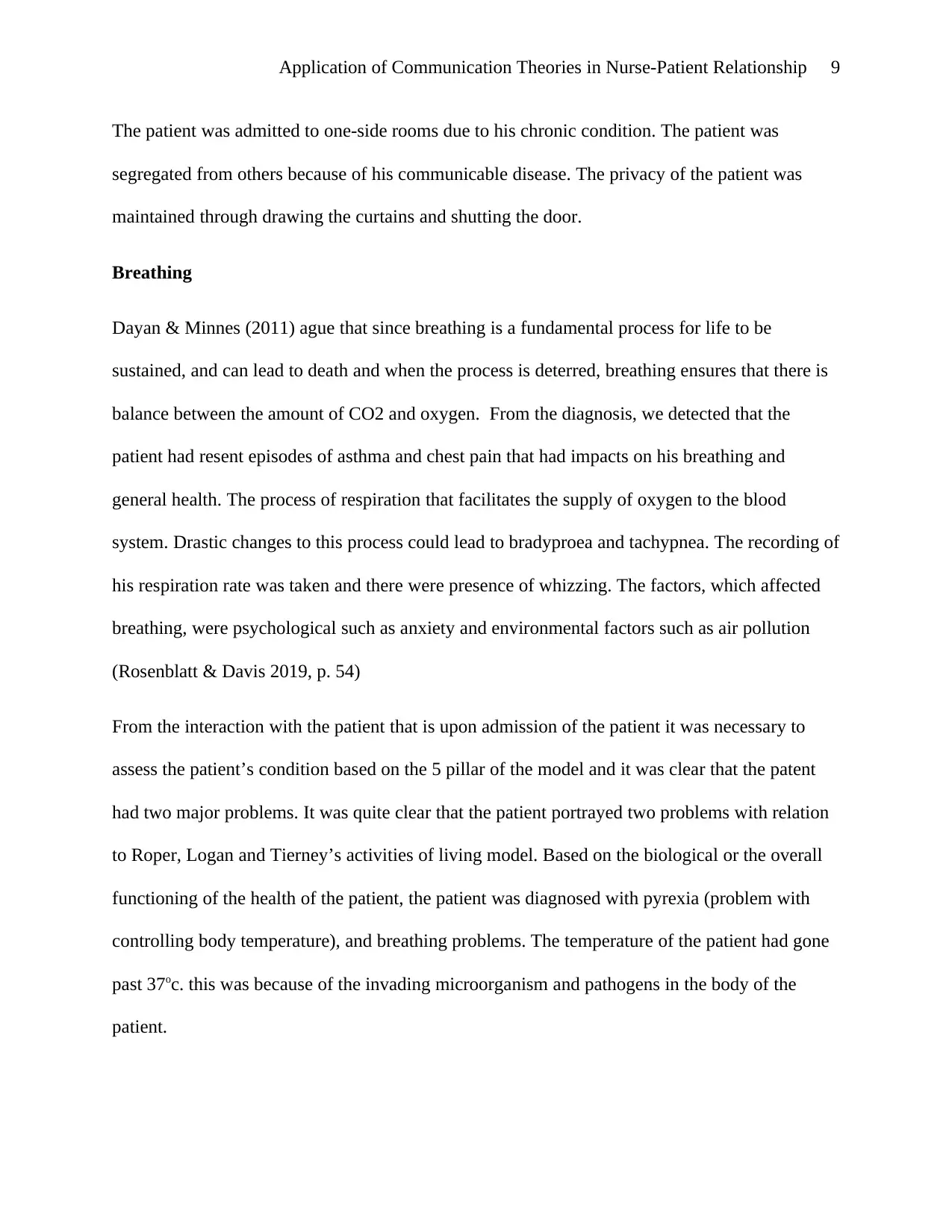
Application of Communication Theories in Nurse-Patient Relationship 9
The patient was admitted to one-side rooms due to his chronic condition. The patient was
segregated from others because of his communicable disease. The privacy of the patient was
maintained through drawing the curtains and shutting the door.
Breathing
Dayan & Minnes (2011) ague that since breathing is a fundamental process for life to be
sustained, and can lead to death and when the process is deterred, breathing ensures that there is
balance between the amount of CO2 and oxygen. From the diagnosis, we detected that the
patient had resent episodes of asthma and chest pain that had impacts on his breathing and
general health. The process of respiration that facilitates the supply of oxygen to the blood
system. Drastic changes to this process could lead to bradyproea and tachypnea. The recording of
his respiration rate was taken and there were presence of whizzing. The factors, which affected
breathing, were psychological such as anxiety and environmental factors such as air pollution
(Rosenblatt & Davis 2019, p. 54)
From the interaction with the patient that is upon admission of the patient it was necessary to
assess the patient’s condition based on the 5 pillar of the model and it was clear that the patent
had two major problems. It was quite clear that the patient portrayed two problems with relation
to Roper, Logan and Tierney’s activities of living model. Based on the biological or the overall
functioning of the health of the patient, the patient was diagnosed with pyrexia (problem with
controlling body temperature), and breathing problems. The temperature of the patient had gone
past 37oc. this was because of the invading microorganism and pathogens in the body of the
patient.
The patient was admitted to one-side rooms due to his chronic condition. The patient was
segregated from others because of his communicable disease. The privacy of the patient was
maintained through drawing the curtains and shutting the door.
Breathing
Dayan & Minnes (2011) ague that since breathing is a fundamental process for life to be
sustained, and can lead to death and when the process is deterred, breathing ensures that there is
balance between the amount of CO2 and oxygen. From the diagnosis, we detected that the
patient had resent episodes of asthma and chest pain that had impacts on his breathing and
general health. The process of respiration that facilitates the supply of oxygen to the blood
system. Drastic changes to this process could lead to bradyproea and tachypnea. The recording of
his respiration rate was taken and there were presence of whizzing. The factors, which affected
breathing, were psychological such as anxiety and environmental factors such as air pollution
(Rosenblatt & Davis 2019, p. 54)
From the interaction with the patient that is upon admission of the patient it was necessary to
assess the patient’s condition based on the 5 pillar of the model and it was clear that the patent
had two major problems. It was quite clear that the patient portrayed two problems with relation
to Roper, Logan and Tierney’s activities of living model. Based on the biological or the overall
functioning of the health of the patient, the patient was diagnosed with pyrexia (problem with
controlling body temperature), and breathing problems. The temperature of the patient had gone
past 37oc. this was because of the invading microorganism and pathogens in the body of the
patient.
⊘ This is a preview!⊘
Do you want full access?
Subscribe today to unlock all pages.

Trusted by 1+ million students worldwide
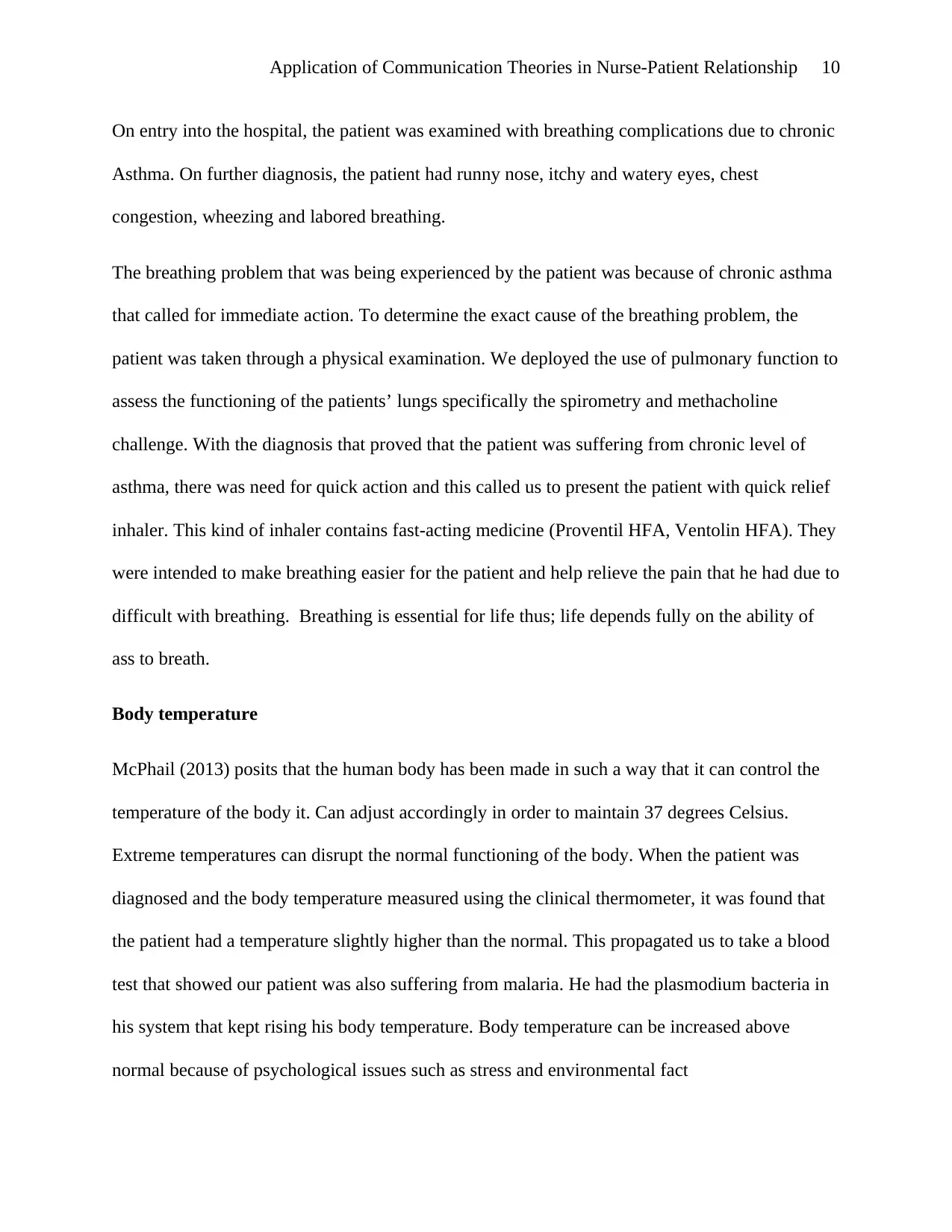
Application of Communication Theories in Nurse-Patient Relationship 10
On entry into the hospital, the patient was examined with breathing complications due to chronic
Asthma. On further diagnosis, the patient had runny nose, itchy and watery eyes, chest
congestion, wheezing and labored breathing.
The breathing problem that was being experienced by the patient was because of chronic asthma
that called for immediate action. To determine the exact cause of the breathing problem, the
patient was taken through a physical examination. We deployed the use of pulmonary function to
assess the functioning of the patients’ lungs specifically the spirometry and methacholine
challenge. With the diagnosis that proved that the patient was suffering from chronic level of
asthma, there was need for quick action and this called us to present the patient with quick relief
inhaler. This kind of inhaler contains fast-acting medicine (Proventil HFA, Ventolin HFA). They
were intended to make breathing easier for the patient and help relieve the pain that he had due to
difficult with breathing. Breathing is essential for life thus; life depends fully on the ability of
ass to breath.
Body temperature
McPhail (2013) posits that the human body has been made in such a way that it can control the
temperature of the body it. Can adjust accordingly in order to maintain 37 degrees Celsius.
Extreme temperatures can disrupt the normal functioning of the body. When the patient was
diagnosed and the body temperature measured using the clinical thermometer, it was found that
the patient had a temperature slightly higher than the normal. This propagated us to take a blood
test that showed our patient was also suffering from malaria. He had the plasmodium bacteria in
his system that kept rising his body temperature. Body temperature can be increased above
normal because of psychological issues such as stress and environmental fact
On entry into the hospital, the patient was examined with breathing complications due to chronic
Asthma. On further diagnosis, the patient had runny nose, itchy and watery eyes, chest
congestion, wheezing and labored breathing.
The breathing problem that was being experienced by the patient was because of chronic asthma
that called for immediate action. To determine the exact cause of the breathing problem, the
patient was taken through a physical examination. We deployed the use of pulmonary function to
assess the functioning of the patients’ lungs specifically the spirometry and methacholine
challenge. With the diagnosis that proved that the patient was suffering from chronic level of
asthma, there was need for quick action and this called us to present the patient with quick relief
inhaler. This kind of inhaler contains fast-acting medicine (Proventil HFA, Ventolin HFA). They
were intended to make breathing easier for the patient and help relieve the pain that he had due to
difficult with breathing. Breathing is essential for life thus; life depends fully on the ability of
ass to breath.
Body temperature
McPhail (2013) posits that the human body has been made in such a way that it can control the
temperature of the body it. Can adjust accordingly in order to maintain 37 degrees Celsius.
Extreme temperatures can disrupt the normal functioning of the body. When the patient was
diagnosed and the body temperature measured using the clinical thermometer, it was found that
the patient had a temperature slightly higher than the normal. This propagated us to take a blood
test that showed our patient was also suffering from malaria. He had the plasmodium bacteria in
his system that kept rising his body temperature. Body temperature can be increased above
normal because of psychological issues such as stress and environmental fact
Paraphrase This Document
Need a fresh take? Get an instant paraphrase of this document with our AI Paraphraser
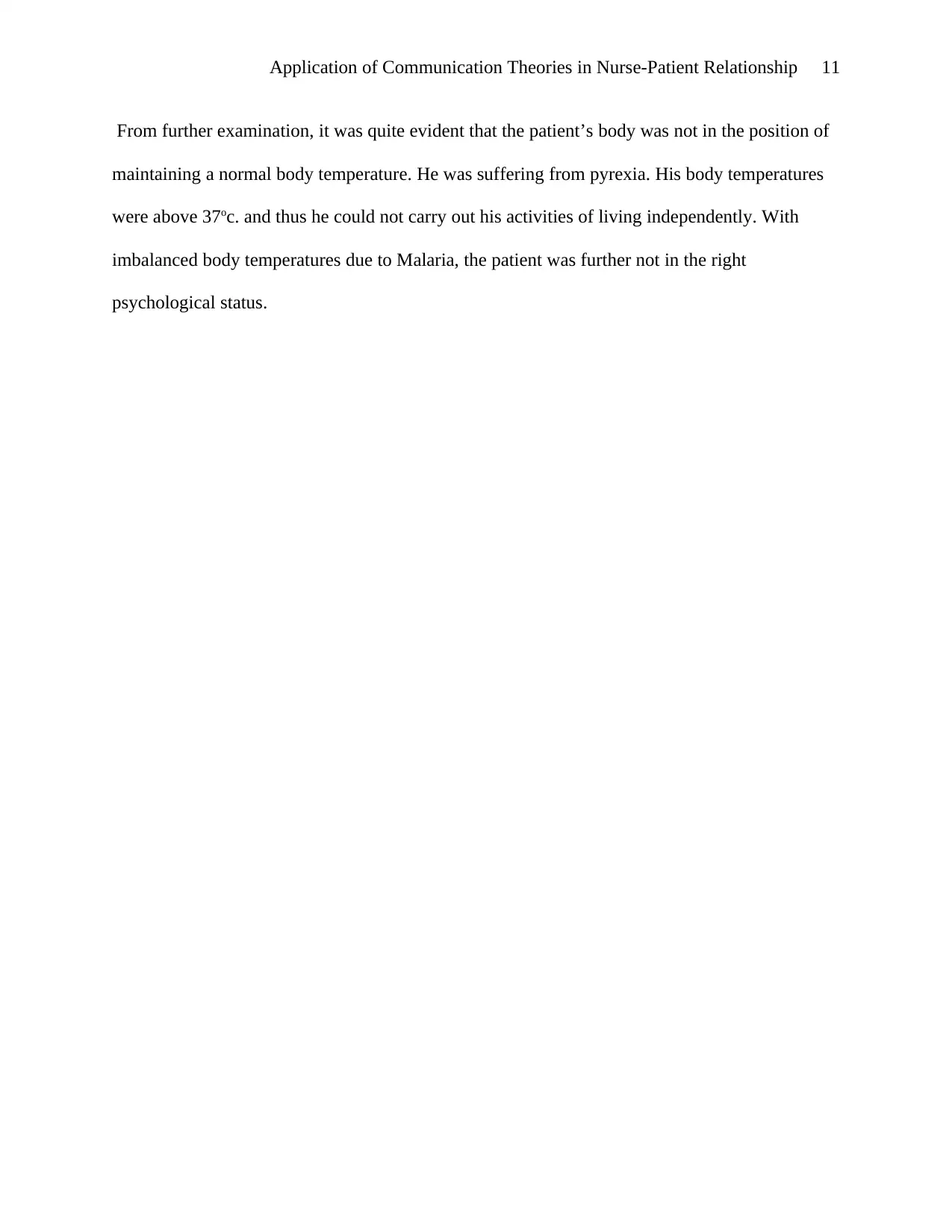
Application of Communication Theories in Nurse-Patient Relationship 11
From further examination, it was quite evident that the patient’s body was not in the position of
maintaining a normal body temperature. He was suffering from pyrexia. His body temperatures
were above 37oc. and thus he could not carry out his activities of living independently. With
imbalanced body temperatures due to Malaria, the patient was further not in the right
psychological status.
From further examination, it was quite evident that the patient’s body was not in the position of
maintaining a normal body temperature. He was suffering from pyrexia. His body temperatures
were above 37oc. and thus he could not carry out his activities of living independently. With
imbalanced body temperatures due to Malaria, the patient was further not in the right
psychological status.
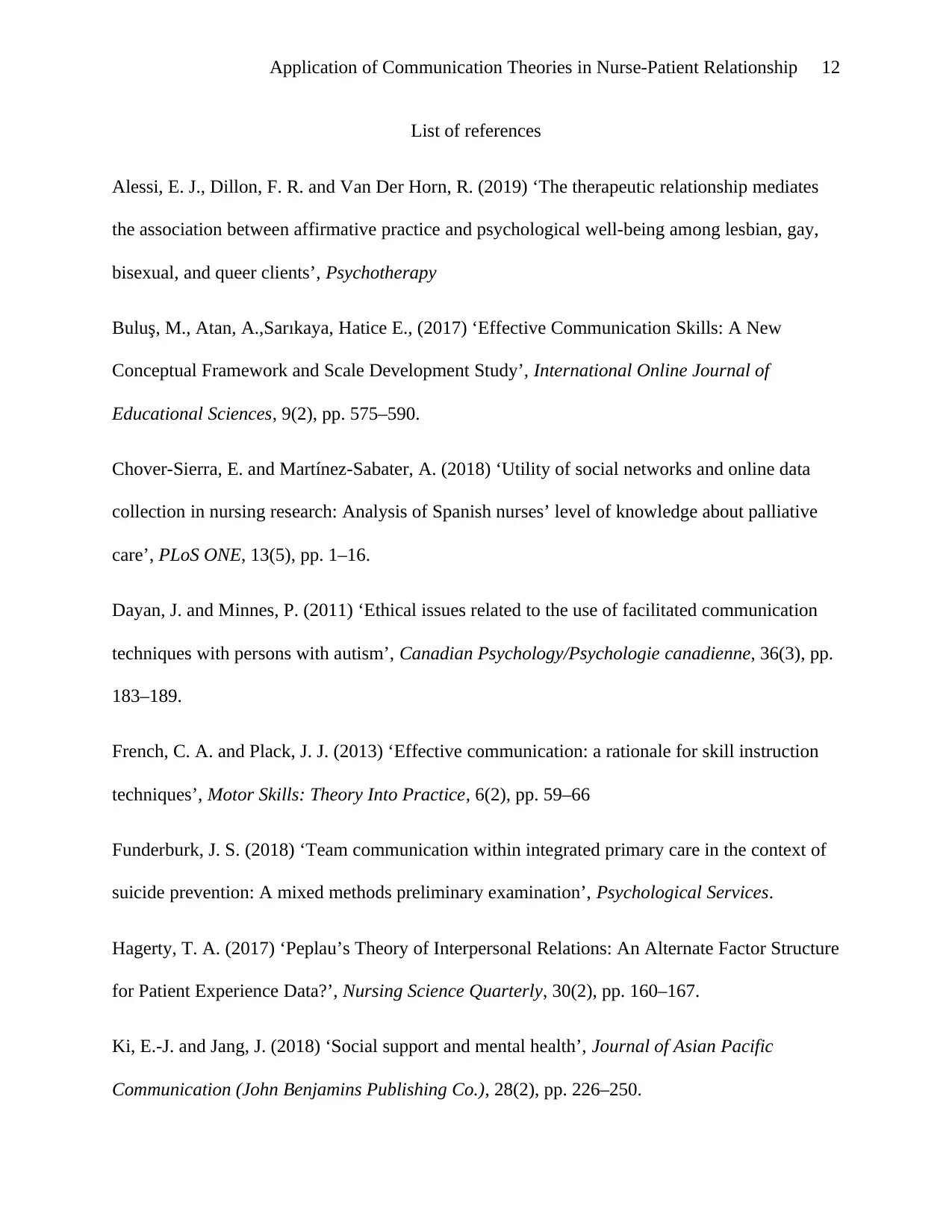
Application of Communication Theories in Nurse-Patient Relationship 12
List of references
Alessi, E. J., Dillon, F. R. and Van Der Horn, R. (2019) ‘The therapeutic relationship mediates
the association between affirmative practice and psychological well-being among lesbian, gay,
bisexual, and queer clients’, Psychotherapy
Buluş, M., Atan, A.,Sarıkaya, Hatice E., (2017) ‘Effective Communication Skills: A New
Conceptual Framework and Scale Development Study’, International Online Journal of
Educational Sciences, 9(2), pp. 575–590.
Chover-Sierra, E. and Martínez-Sabater, A. (2018) ‘Utility of social networks and online data
collection in nursing research: Analysis of Spanish nurses’ level of knowledge about palliative
care’, PLoS ONE, 13(5), pp. 1–16.
Dayan, J. and Minnes, P. (2011) ‘Ethical issues related to the use of facilitated communication
techniques with persons with autism’, Canadian Psychology/Psychologie canadienne, 36(3), pp.
183–189.
French, C. A. and Plack, J. J. (2013) ‘Effective communication: a rationale for skill instruction
techniques’, Motor Skills: Theory Into Practice, 6(2), pp. 59–66
Funderburk, J. S. (2018) ‘Team communication within integrated primary care in the context of
suicide prevention: A mixed methods preliminary examination’, Psychological Services.
Hagerty, T. A. (2017) ‘Peplau’s Theory of Interpersonal Relations: An Alternate Factor Structure
for Patient Experience Data?’, Nursing Science Quarterly, 30(2), pp. 160–167.
Ki, E.-J. and Jang, J. (2018) ‘Social support and mental health’, Journal of Asian Pacific
Communication (John Benjamins Publishing Co.), 28(2), pp. 226–250.
List of references
Alessi, E. J., Dillon, F. R. and Van Der Horn, R. (2019) ‘The therapeutic relationship mediates
the association between affirmative practice and psychological well-being among lesbian, gay,
bisexual, and queer clients’, Psychotherapy
Buluş, M., Atan, A.,Sarıkaya, Hatice E., (2017) ‘Effective Communication Skills: A New
Conceptual Framework and Scale Development Study’, International Online Journal of
Educational Sciences, 9(2), pp. 575–590.
Chover-Sierra, E. and Martínez-Sabater, A. (2018) ‘Utility of social networks and online data
collection in nursing research: Analysis of Spanish nurses’ level of knowledge about palliative
care’, PLoS ONE, 13(5), pp. 1–16.
Dayan, J. and Minnes, P. (2011) ‘Ethical issues related to the use of facilitated communication
techniques with persons with autism’, Canadian Psychology/Psychologie canadienne, 36(3), pp.
183–189.
French, C. A. and Plack, J. J. (2013) ‘Effective communication: a rationale for skill instruction
techniques’, Motor Skills: Theory Into Practice, 6(2), pp. 59–66
Funderburk, J. S. (2018) ‘Team communication within integrated primary care in the context of
suicide prevention: A mixed methods preliminary examination’, Psychological Services.
Hagerty, T. A. (2017) ‘Peplau’s Theory of Interpersonal Relations: An Alternate Factor Structure
for Patient Experience Data?’, Nursing Science Quarterly, 30(2), pp. 160–167.
Ki, E.-J. and Jang, J. (2018) ‘Social support and mental health’, Journal of Asian Pacific
Communication (John Benjamins Publishing Co.), 28(2), pp. 226–250.
⊘ This is a preview!⊘
Do you want full access?
Subscribe today to unlock all pages.

Trusted by 1+ million students worldwide
1 out of 13
Related Documents
Your All-in-One AI-Powered Toolkit for Academic Success.
+13062052269
info@desklib.com
Available 24*7 on WhatsApp / Email
![[object Object]](/_next/static/media/star-bottom.7253800d.svg)
Unlock your academic potential
Copyright © 2020–2025 A2Z Services. All Rights Reserved. Developed and managed by ZUCOL.





